Musculoskeletal Disorder Risk Assessment during the Tennis Serve: Performance and Prevention
Abstract
:1. Introduction
2. Materials and Methods
2.1. Participants
2.2. Experimental Task
2.3. Equipment
2.4. Data Processing
2.5. Statistical Analysis
3. Results
3.1. MSD Assessment: REBA Analysis
3.2. Performance and Prevention: Slow vs. Fast Serves
4. Discussion
4.1. Tennis Serve and MSD Risk
4.2. MSD Prevention and Performance
4.3. Application of Key Findings
4.4. Limitations
5. Conclusions
Author Contributions
Funding
Institutional Review Board Statement
Informed Consent Statement
Data Availability Statement
Conflicts of Interest
Appendix A
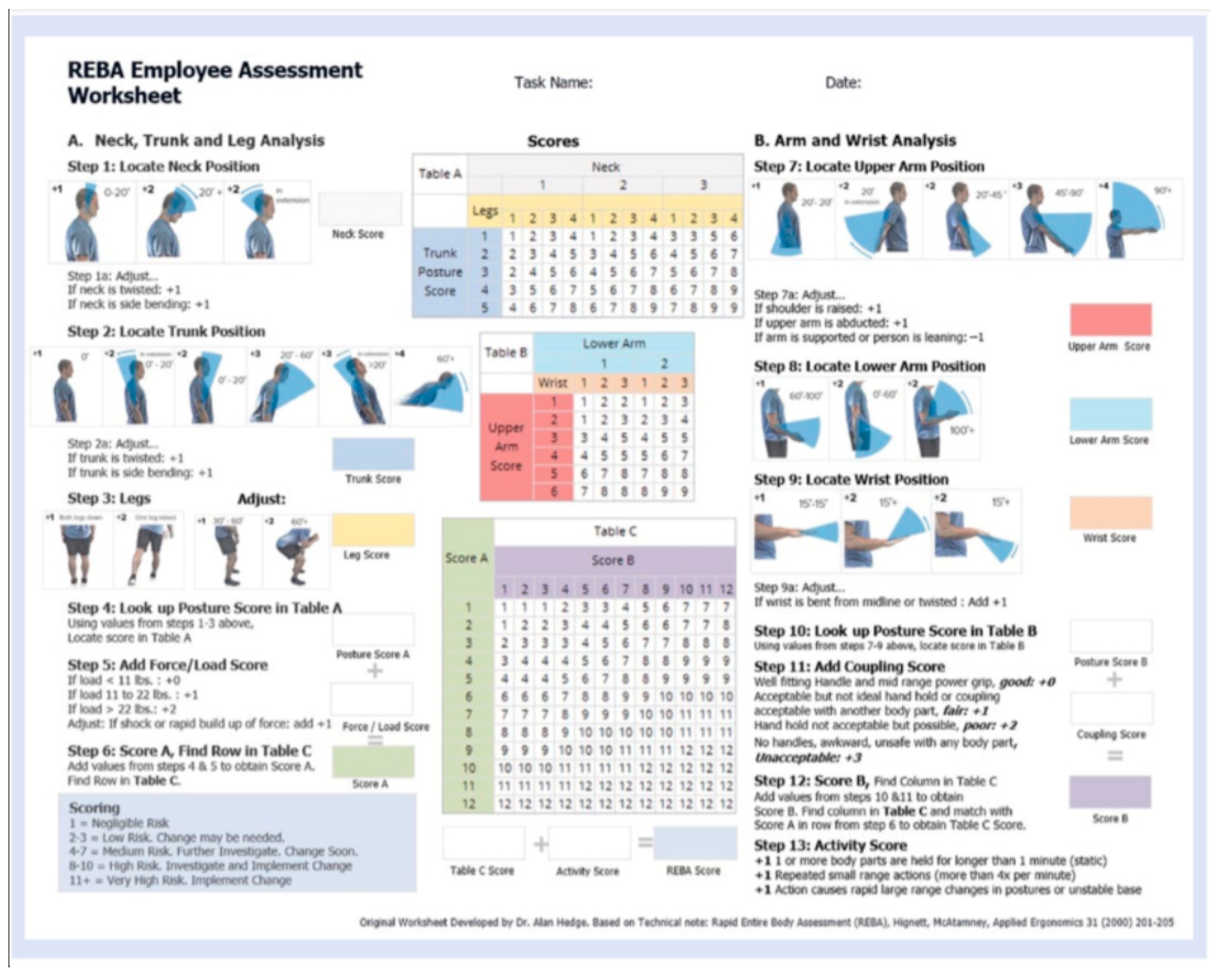
References
- Kovacs, M.; Ellenbecker, T. An 8-Stage Model for Evaluating the Tennis Serve:Implications for Performance Enhancement and Injury Prevention. Sports Health 2011, 3, 504–513. [Google Scholar] [CrossRef] [PubMed]
- Whiteside, D.; Elliott, B.; Lay, B.; Reid, M. A kinematic comparison of successful and unsuccessful tennis serves across the elite development pathway. Hum. Mov. Sci. 2013, 32, 822–835. [Google Scholar] [CrossRef]
- Reid, M.; Elliott, B.; Alderson, J. Lower-limb coordination and shoulder joint mechanics in the tennis serve. Med. Sci. Sports Exerc. 2008, 40, 308–315. [Google Scholar] [CrossRef] [PubMed]
- Elliott, B.; Wood, G. The biomechanics of the foot-up and foot-back tennis service techniques. Aust. J. Sci. Med. Sport 1983, 3, 3–6. [Google Scholar]
- Hornestam, J.F.; Souza, T.R.; Magalhaes, F.A.; Begon, M.; Santos, T.R.T.; Fonseca, S.T. The Effects of Knee Flexion on Tennis Serve Performance of Intermediate Level Tennis Players. Sensors 2021, 21, 5254. [Google Scholar] [CrossRef]
- Reid, M.; Elliott, B.; Alderson, J. Shoulder joint loading in the high performance flat and kick tennis serves. Br. J. Sports Med. 2007, 41, 884–889. [Google Scholar] [CrossRef] [PubMed]
- Jacquier-Bret, J.; Gorce, P. Kinematics characteristics of key point of interest during tennis serve among tennis players: A systematic review and meta-analysis. Front. Sports Act. Living 2024, 6, 1432030. [Google Scholar] [CrossRef]
- Whiteside, D.; Elliott, B.; Lay, B.; Reid, M. The effect of age on discrete kinematics of the elite female tennis serve. J. Appl. Biomech. 2013, 29, 573–582. [Google Scholar] [CrossRef]
- Wang, L.H.; Lo, K.C.; Su, F.C. Skill level and forearm muscle fatigue effects on ball speed in tennis serve. Sports Biomech. 2021, 20, 419–430. [Google Scholar] [CrossRef]
- Brocherie, F.; Dinu, D. Biomechanical estimation of tennis serve using inertial sensors: A case study. Front. Sports Act. Living 2022, 4, 962941. [Google Scholar] [CrossRef]
- Elliott, B.; Marsh, T.; Blanksby, B. A Three-Dimensional Cinematographic Analysis of the Tennis Serve. Int. J. Sport Biomech. 1986, 2, 260–271. [Google Scholar] [CrossRef]
- Tubez, F.; Schwartz, C.; Croisier, J.-L.; Brüls, O.; Denoël, V.; Paulus, J.; Forthomme, B. Evolution of the trophy position along the tennis serve player’s development. Sports Biomech. 2021, 20, 431–443. [Google Scholar] [CrossRef] [PubMed]
- Mourtzios, C.; Athanailidis, I.; Arvanitidou, V.; Kellis, E. Ankle and Knee Joint Kinematics Differ between Flat, Slice and Topspin Serves in Young Tennis Players. Eur. J. Sport Sci. 2022, 1, 16–22. [Google Scholar] [CrossRef]
- Touzard, P.; Lecomte, C.; Bideau, B.; Kulpa, R.; Fourel, L.; Fadier, M.; Cantin, N.; Martin, C. There is no rush to upgrade the tennis racket in young intermediate competitive players: The effects of scaling racket on serve biomechanics and performance. Front. Psychol. 2023, 14, 1104146. [Google Scholar] [CrossRef] [PubMed]
- Fadier, M.; Touzard, P.; Martin, C. Preliminary kinematic analysis of the serve in 10 and under players. Coach. Sport Sci. Rev. 2021, 29, 12–14. [Google Scholar] [CrossRef]
- Gillet, B.; Rogowski, I.; Monga-Dubreuil, E.; Begon, M. Lower Trapezius Weakness and Shoulder Complex Biomechanics during the Tennis Serve. Med. Sci. Sports Exerc. 2019, 51, 2531–2539. [Google Scholar] [CrossRef]
- Rogowski, I.; Creveaux, T.; Sevrez, V.; Cheze, L.; Dumas, R. How Does the Scapula Move during the Tennis Serve? Med. Sci. Sports Exerc. 2015, 47, 1444–1449. [Google Scholar] [CrossRef] [PubMed]
- Abrams, G.D.; Harris, A.H.; Andriacchi, T.P.; Safran, M.R. Biomechanical analysis of three tennis serve types using a markerless system. Br. J. Sports Med. 2014, 48, 339–342. [Google Scholar] [CrossRef]
- Fett, J.; Oberschelp, N.; Vuong, J.L.; Wiewelhove, T.; Ferrauti, A. Kinematic characteristics of the tennis serve from the ad and deuce court service positions in elite junior players. PLoS ONE 2021, 16, e0252650. [Google Scholar] [CrossRef]
- Reid, M.; Giblin, G.; Whiteside, D. A kinematic comparison of the overhand throw and tennis serve in tennis players: How similar are they really? J. Sports Sci. 2014, 33, 713–723. [Google Scholar] [CrossRef]
- Fleisig, G.; Nicholls, R.; Elliott, B.; Escamilla, R. Kinematics used by world class tennis players to produce high-velocity serves. Sports Biomech. 2003, 2, 51–64. [Google Scholar] [CrossRef]
- Gomez-Galan, M.; Perez-Alonso, J.; Callejon-Ferre, A.J.; Lopez-Martinez, J. Musculoskeletal disorders: OWAS review. Ind. Health 2017, 55, 314–337. [Google Scholar] [CrossRef] [PubMed]
- Rothrauff, B.B.; Pirosa, A.; Lin, H.; Sohn, J.; Langhans, M.T.; Tuan, R.S. Chapter 54—Stem Cell Therapy for Musculoskeletal Diseases. In Principles of Regenerative Medicine, 3rd ed.; Atala, A., Lanza, R., Mikos, A.G., Nerem, R., Eds.; Academic Press: Boston, MA, USA, 2019; pp. 953–970. [Google Scholar]
- Martin, C.; Kulpa, R.; Ropars, M.; Delamarche, P.; Bideau, B. Identification of temporal pathomechanical factors during the tennis serve. Med. Sci. Sports Exerc. 2013, 45, 2113–2119. [Google Scholar] [CrossRef] [PubMed]
- Gomez-Galan, M.; Callejon-Ferre, A.J.; Perez-Alonso, J.; Diaz-Perez, M.; Carrillo-Castrillo, J.A. Musculoskeletal Risks: RULA Bibliometric Review. Int. J. Environ. Res. Public Health 2020, 17, 4354. [Google Scholar] [CrossRef]
- Hignett, S.; McAtamney, L. Rapid Entire Body Assessment (REBA). Appl. Ergon. 2000, 31, 201–205. [Google Scholar] [CrossRef]
- McAtamney, L.; Corlett, N.E. RULA: A survey method for the investigation of work-related upper limb disorders. Appl. Ergon. 1993, 24, 91–99. [Google Scholar] [CrossRef]
- Kee, D.; Karwowski, W. LUBA: An assessment technique for postural loading on the upper body based on joint motion discomfort and maximum holding time. Appl. Ergon. 2001, 32, 357–366. [Google Scholar] [CrossRef]
- Karhu, O.; Kansi, P.; Kuorinka, I. Correcting working postures in industry: A practical method for analysis. Appl. Ergon. 1977, 8, 199–201. [Google Scholar] [CrossRef] [PubMed]
- Rose, L.M.; Eklund, J.; Nord Nilsson, L.; Barman, L.; Lind, C.M. The RAMP package for MSD risk management in manual handling—A freely accessible tool, with website and training courses. Appl. Ergon. 2020, 86, 103101. [Google Scholar] [CrossRef]
- Perkins, R.H.; Davis, D. Musculoskeletal injuries in tennis. Phys. Med. Rehabil. Clin. N. Am. 2006, 17, 609–631. [Google Scholar] [CrossRef]
- Wu, G.; Siegler, S.; Allard, P.; Kirtley, C.; Leardini, A.; Rosenbaum, D.; Whittle, M.; D’Lima, D.D.; Cristofolini, L.; Witte, H.; et al. ISB recommendation on definitions of joint coordinate system of various joints for the reporting of human joint motion—Part I: Ankle, hip, and spine. J. Biomech. 2002, 35, 543–548. [Google Scholar] [CrossRef] [PubMed]
- Wu, G.; van der Helm, F.C.T.; Veeger, H.E.J.; Makhsous, M.; Van Roy, P.; Anglin, C.; Nagels, J.; Karduna, A.R.; McQuade, K.; Wang, X.; et al. ISB recommendation on definitions of joint coordinate systems of various joints for the reporting of human joint motion—Part II: Shoulder, elbow, wrist and hand. J. Biomech. 2005, 38, 981–992. [Google Scholar] [CrossRef] [PubMed]
- Jacquier-Bret, J.; Gorce, P. Kinematics of the Tennis Serve Using an Optoelectronic Motion Capture System: Are There Correlations between Joint Angles and Racket Velocity? Sensors 2024, 24, 3292. [Google Scholar] [CrossRef] [PubMed]
- Lu, T.-W.; O’Connor, J.J. Bone position estimation from skin marker co-ordinates using global optimisation with joint constraints. J. Biomech. 1999, 32, 129–134. [Google Scholar] [CrossRef] [PubMed]
- Bonnefoy-Mazure, A.; Slawinski, J.; Riquet, A.; Leveque, J.M.; Miller, C.; Cheze, L. Rotation sequence is an important factor in shoulder kinematics. Application to the elite players’ flat serves. J. Biomech. 2010, 43, 2022–2025. [Google Scholar] [CrossRef]
- Raman, V.; Ramlogan, S.; Sweet, J.; Sweet, D. Application of the Rapid Entire Body Assessment (REBA) in assessing chairside ergonomic risk of dental students. Br. Dent. J. 2020; online publication. [Google Scholar] [CrossRef]
- Bylak, J.; Hutchinson, M.R. Common sports injuries in young tennis players. Sports Med. 1998, 26, 119–132. [Google Scholar] [CrossRef]
- Peters, T.; Baker, C.L., Jr. Lateral epicondylitis. Clin. Sports Med. 2001, 20, 549–563. [Google Scholar] [CrossRef] [PubMed]
- Rettig, A.C. Wrist problems in the tennis player. Med. Sci. Sports Exerc. 1994, 26, 1207–1212. [Google Scholar] [CrossRef]
- Marks, M.R.; Haas, S.S.; Wiesel, S.W. Low back pain in the competitive tennis player. Clin. Sports Med. 1988, 7, 277–287. [Google Scholar] [CrossRef]
- Hainline, B. Low back injury. Clin. Sports Med. 1995, 14, 241–265. [Google Scholar] [CrossRef]
- Gecha, S.R.; Torg, E. Knee injuries in tennis. Clin. Sports Med. 1988, 7, 435–452. [Google Scholar] [CrossRef] [PubMed]
- Zecher, S.B.; Leach, R.E. Lower leg and foot injuries in tennis and other racquet sports. Clin. Sports Med. 1995, 14, 223–239. [Google Scholar] [CrossRef] [PubMed]
- Lee, H.W. Mechanisms of neck and shoulder injuries in tennis players. J. Orthop. Sports Phys. Ther. 1995, 21, 28–37. [Google Scholar] [CrossRef] [PubMed]
- Grieve, G.P. Common Vertebral Joint Problems; Churchill Livingstone: London, UK, 1988; p. 804. [Google Scholar]
- Wagner, H.; Pfusterschmied, J.; Tilp, M.; Landlinger, J.; von Duvillard, S.P.; Muller, E. Upper-body kinematics in team-handball throw, tennis serve, and volleyball spike. Scand. J. Med. Sci. Sports 2014, 24, 345–354. [Google Scholar] [CrossRef] [PubMed]
- Haberl, H.; Cripton, P.A.; Orr, T.E.; Beutler, T.; Frei, H.; Lanksch, W.R.; Nolte, L.P. Kinematic response of lumbar functional spinal units to axial torsion with and without superimposed compression and flexion/extension. Eur. Spine J. 2004, 13, 560–566. [Google Scholar] [CrossRef]
- Campbell, A.; Straker, L.; O’Sullivan, P.; Elliott, B.; Reid, M. Lumbar loading in the elite adolescent tennis serve: Link to low back pain. Med. Sci. Sports Exerc. 2013, 45, 1562–1568. [Google Scholar] [CrossRef]
- Konda, S.; Yanai, T.; Sakurai, S. Scapular rotation to attain the peak shoulder external rotation in tennis serve. Med. Sci. Sports Exerc. 2010, 42, 1745–1753. [Google Scholar] [CrossRef]
- Jobe, F.W.; Bradley, J.P. The diagnosis and nonoperative treatment of shoulder injuries in athletes. Clin. Sports Med. 1989, 8, 419–438. [Google Scholar] [CrossRef]
- van der Hoeven, H.; Kibler, W.B. Shoulder injuries in tennis players. Br. J. Sports Med. 2006, 40, 435–440; discussion 440. [Google Scholar] [CrossRef]
- Kibler, W.B. Clinical biomechanics of the elbow in tennis: Implications for evaluation and diagnosis. Med. Sci. Sports Exerc. 1994, 26, 1203–1206. [Google Scholar] [CrossRef]
- Eygendaal, D.; Rahussen, F.T.; Diercks, R.L. Biomechanics of the elbow joint in tennis players and relation to pathology. Br. J. Sports Med. 2007, 41, 820–823. [Google Scholar] [CrossRef] [PubMed]
- De Smedt, T.; de Jong, A.; Van Leemput, W.; Lieven, D.; Van Glabbeek, F. Lateral epicondylitis in tennis: Update on aetiology, biomechanics and treatment. Br. J. Sports Med. 2007, 41, 816–819. [Google Scholar] [CrossRef] [PubMed]
- Kekelekis, A.; Nikolaidis, P.T.; Moore, I.S.; Rosemann, T.; Knechtle, B. Risk Factors for Upper Limb Injury in Tennis Players: A Systematic Review. Int. J. Environ. Res. Public Health 2020, 17, 2744. [Google Scholar] [CrossRef] [PubMed]
- Hennig, E.M.; Rosenbaum, D.; Milani, T.L. Transfer of tennis racket vibrations onto the human forearm. Med. Sci. Sports Exerc. 1992, 24, 1134–1140. [Google Scholar] [CrossRef] [PubMed]
- Marx, R.G.; Sperling, J.W.; Cordasco, F.A. Overuse injuries of the upper extremity in tennis players. Clin. Sports Med. 2001, 20, 439–451. [Google Scholar] [CrossRef] [PubMed]
- Patel, H.; Lala, S.; Helfner, B.; Wong, T.T. Tennis overuse injuries in the upper extremity. Skelet. Radiol. 2021, 50, 629–644. [Google Scholar] [CrossRef]
- Kibler, W.B.; Safran, M. Tennis injuries. Med. Sport Sci. 2005, 48, 120–137. [Google Scholar] [CrossRef]
- Bahamonde, R.E.; Knudson, D. Kinetics of the upper extremity in the open and square stance tennis forehand. J. Sci. Med. Sport 2003, 6, 88–101. [Google Scholar] [CrossRef]
- Pluim, B.M.; Staal, J.B.; Windler, G.E.; Jayanthi, N. Tennis injuries: Occurrence, aetiology, and prevention. Br. J. Sports Med. 2006, 40, 415–423. [Google Scholar] [CrossRef]
- Reid, M.; Duffield, R. The development of fatigue during match-play tennis. Br. J. Sports Med. 2014, 48 (Suppl. 1), i7–i11. [Google Scholar] [CrossRef]
- Renstrom, A.F. Knee pain in tennis players. Clin. Sports Med. 1995, 14, 163–175. [Google Scholar] [CrossRef] [PubMed]
- Reid, M.; Giblin, G. Another day, another tennis coaching intervention, but does this one do what coaches purport? Sports Biomech. 2015, 14, 180–189. [Google Scholar] [CrossRef] [PubMed]
- Shafizadeh, M.; Bonner, S.; Barnes, A.; Fraser, J. Effects of task and environmental constraints on axial kinematic synergies during the tennis service in expert players. Eur. J. Sport. Sci. 2019, 20, 1178–1186. [Google Scholar] [CrossRef] [PubMed]

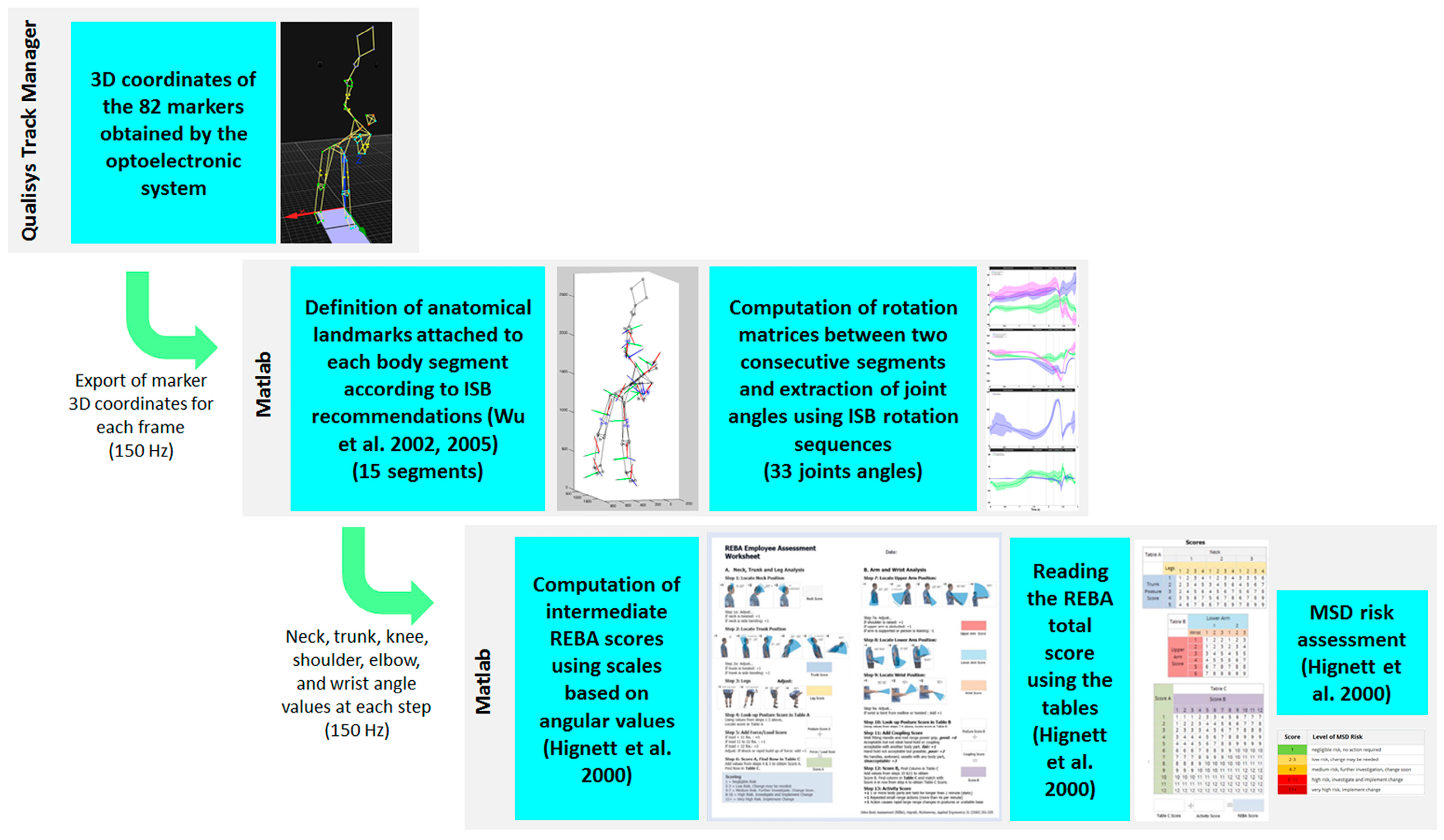
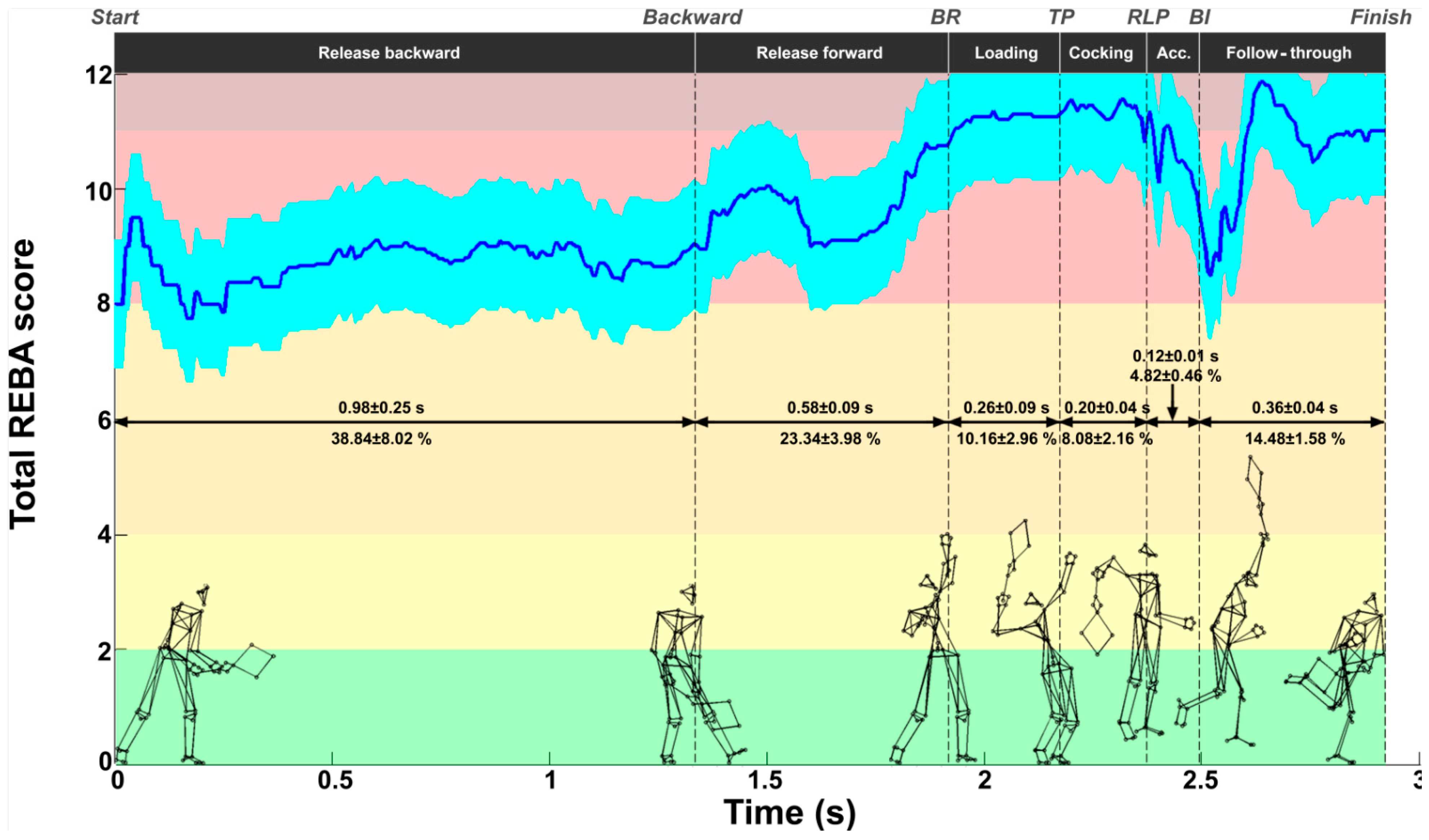

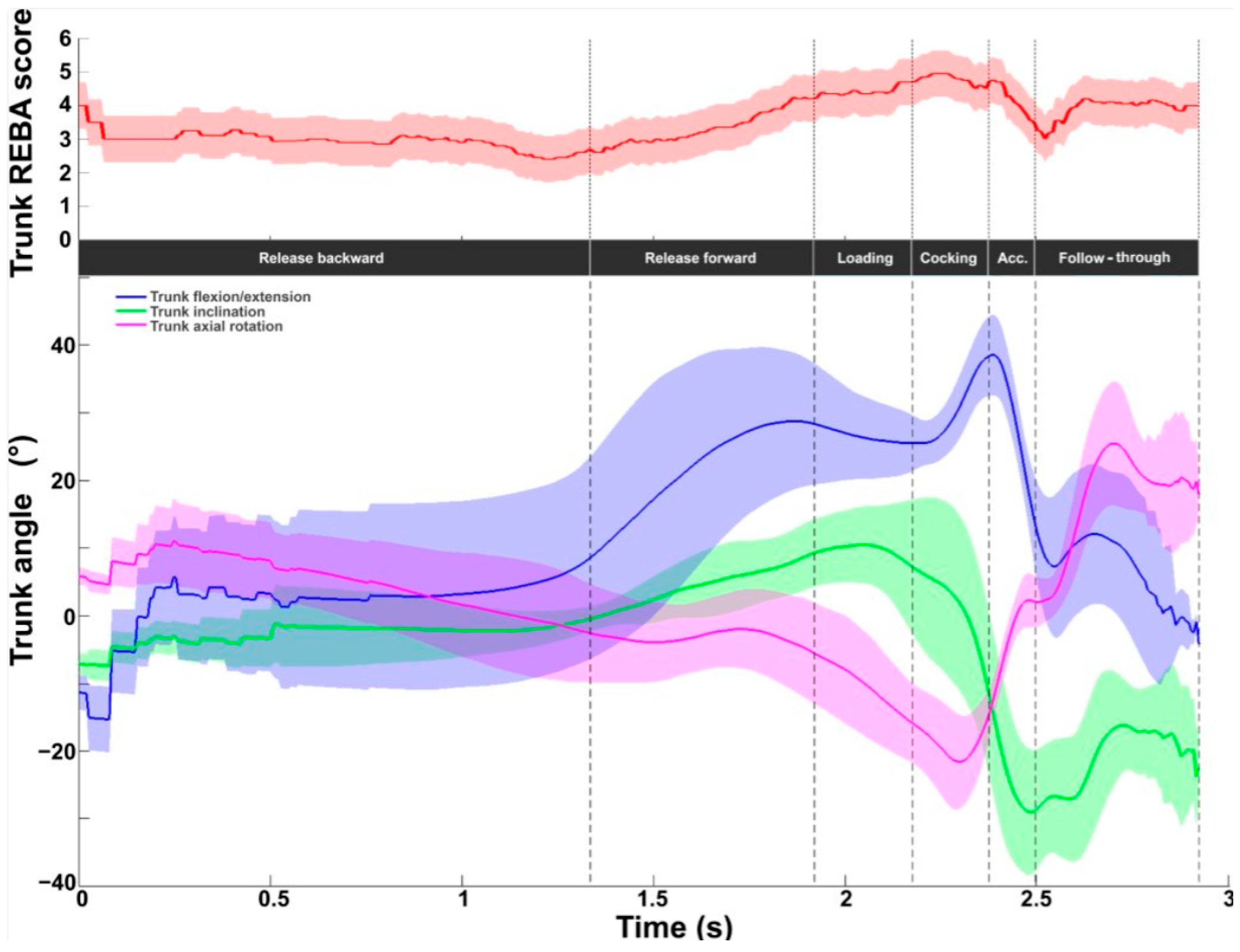
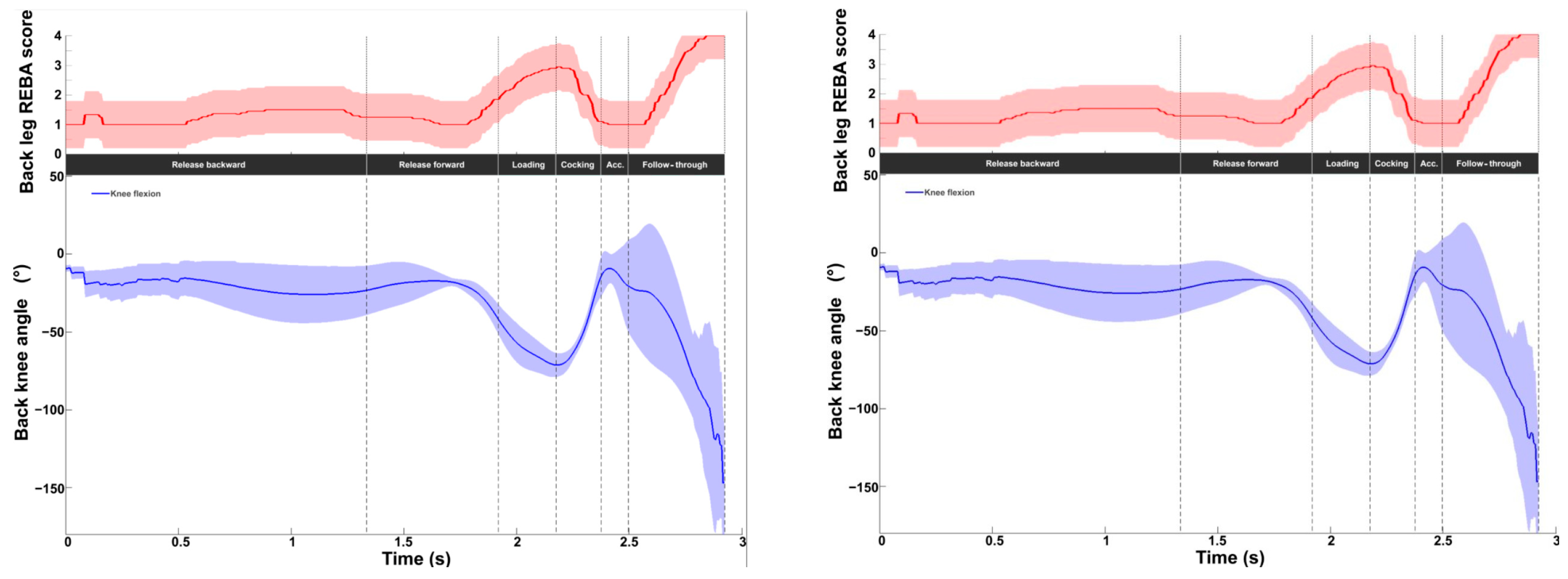
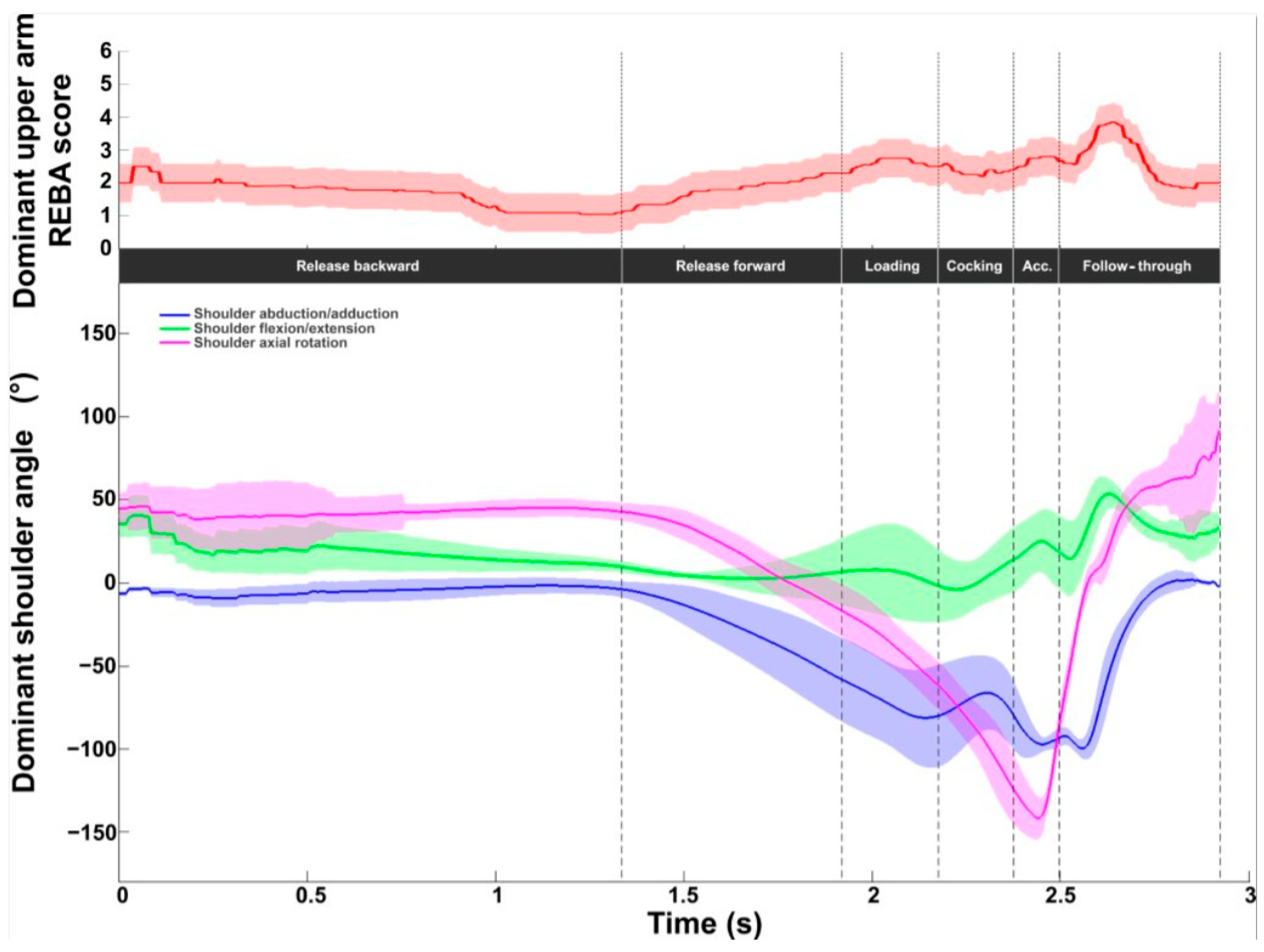

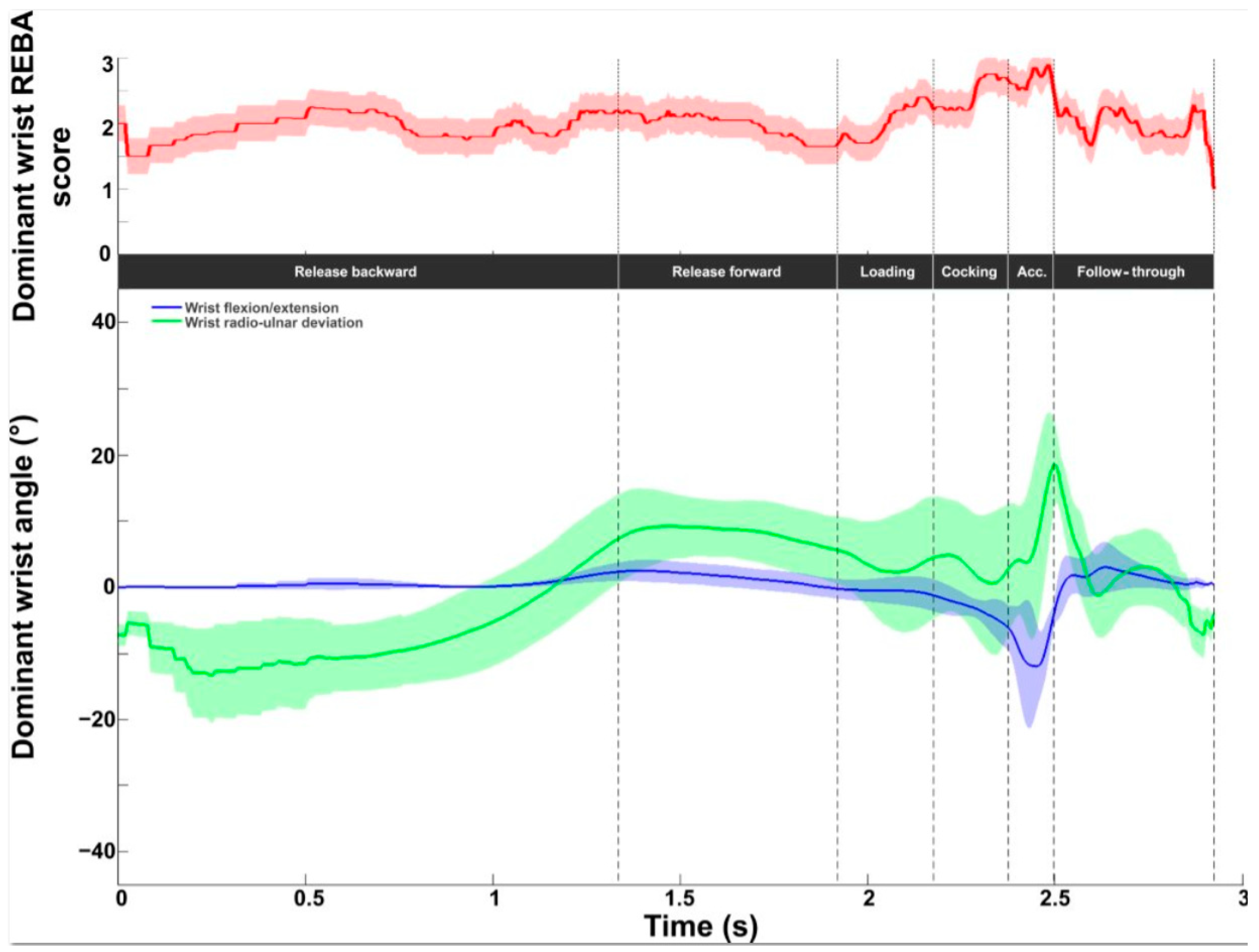
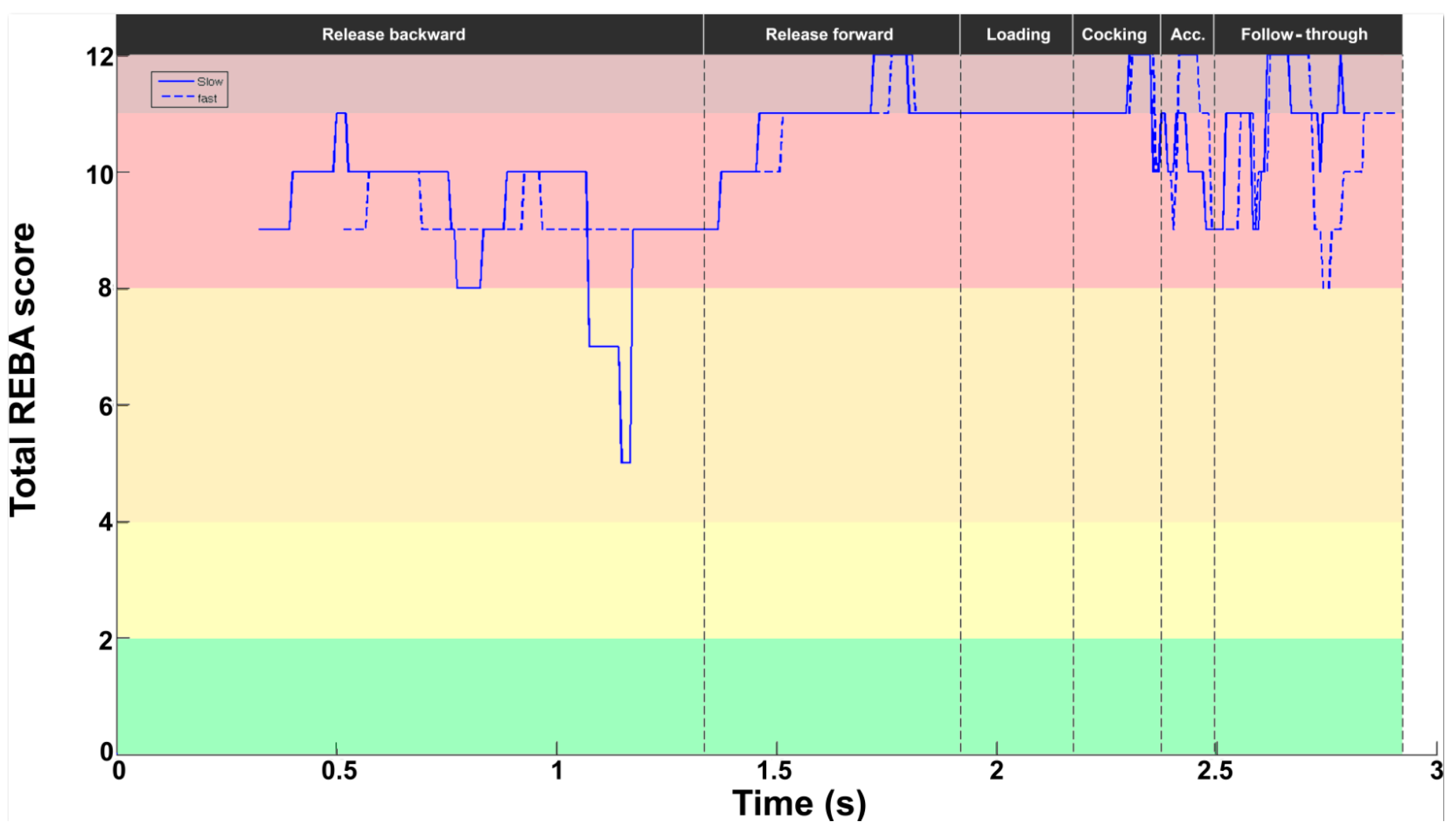



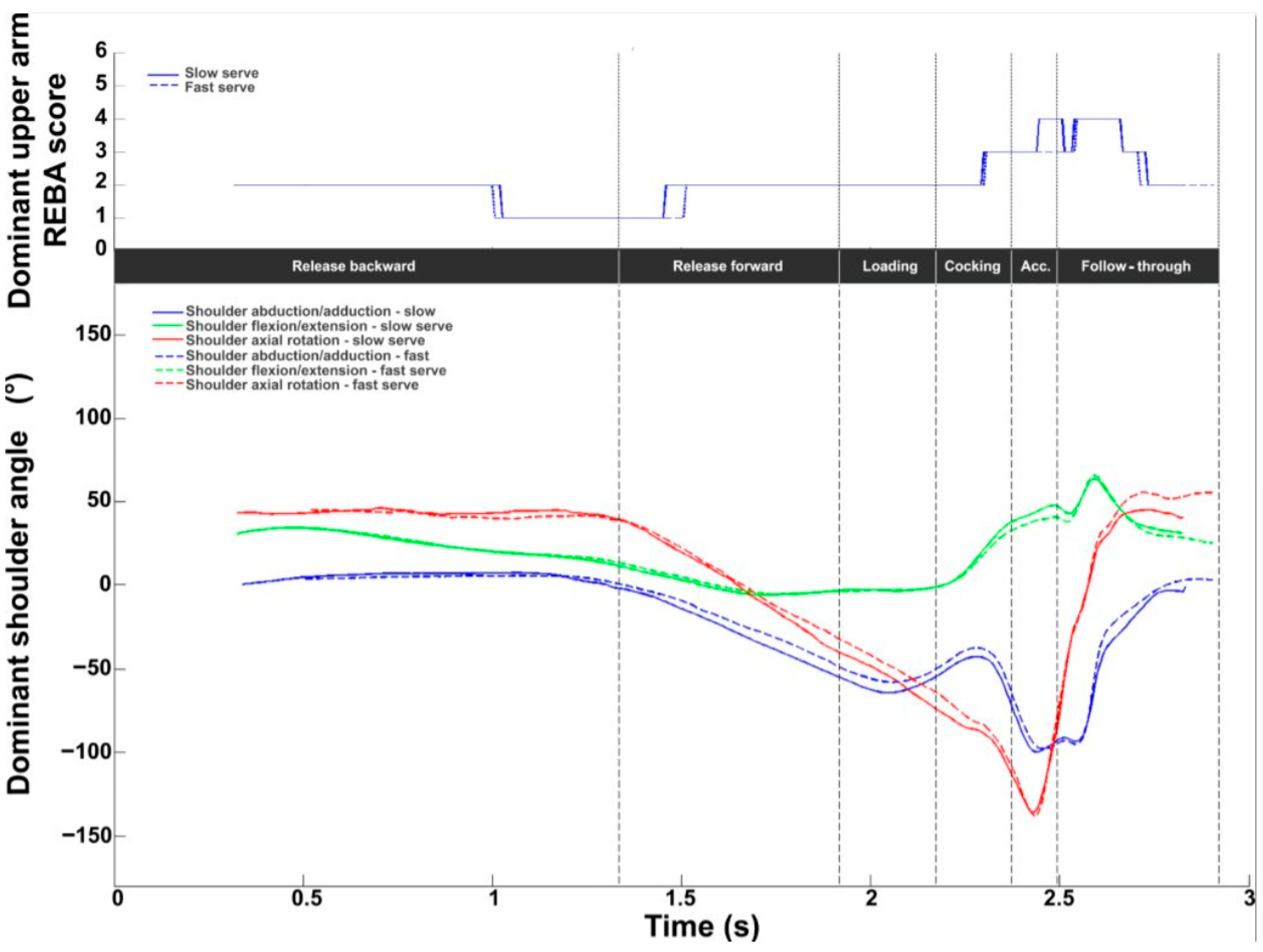
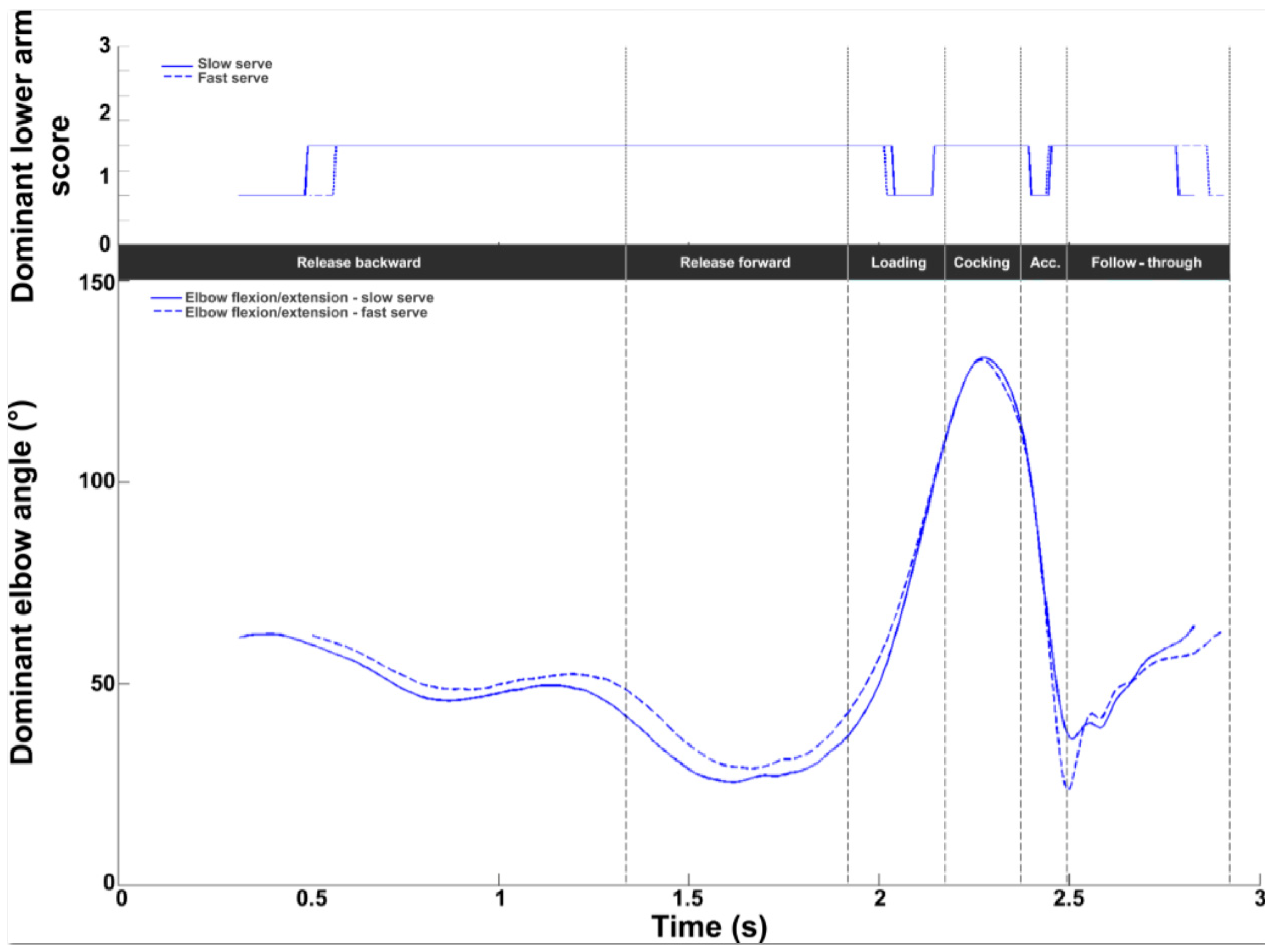
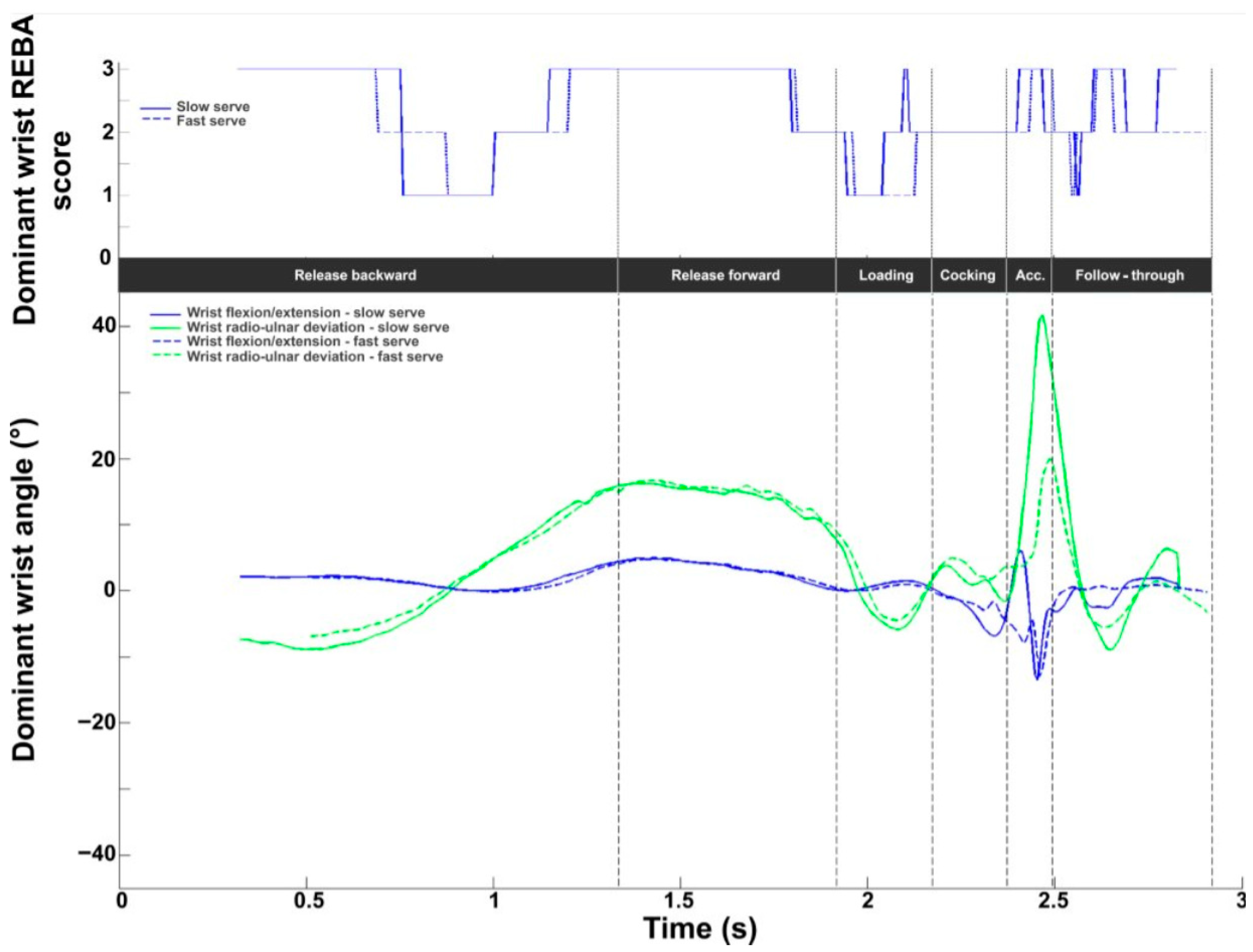
| Player 1 | Player 2 | Player 3 | Player 4 | Mean ± Std | |
|---|---|---|---|---|---|
| Sex | Male | Male | Female | Female | |
| Age (year) | 21 | 17 | 17 | 16 | 17.8 ± 2.2 |
| Height (m) | 1.75 | 1.74 | 1.63 | 1.59 | 1.66 ± 0.08 |
| Weight (kg) | 58.1 | 61.0 | 58.8 | 50.4 | 56.5 ± 4.6 |
| BMI | 19.0 | 20.2 | 22.1 | 19.9 | 20.3 ± 1.3 |
| Training by week (h) | 15.0 | 15.0 | 15.0 | 15.0 | 15.0 ± 0.0 |
| Level | National | National | National | National |
| Start | Backward | BR | TP | RLP | BI | Finish | ||
|---|---|---|---|---|---|---|---|---|
| Player 1 | Serve 1 | 9 | 9 | 11 | 11 | 10 | 9 | 11 |
| Serve 2 | 10 | 9 | 11 | 11 | 11 | 9 | 12 | |
| Serve 3 | 9 | 9 | 11 | 11 | 11 | 9 | 11 | |
| Serve 4 | 9 | 9 | 11 | 11 | 11 | 9 | 11 | |
| Serve 5 | 10 | 9 | 11 | 11 | 11 | 9 | 11 | |
| Player 2 | Serve 1 | 7 | 10 | 11 | 12 | 12 | 7 | 11 |
| Serve 2 | 7 | 10 | 7 | 12 | 12 | 10 | 11 | |
| Serve 3 | 7 | 8 | 8 | 11 | 10 | 10 | 10 | |
| Serve 4 | 8 | 8 | 7 | 12 | 10 | 10 | 11 | |
| Serve 5 | 7 | 8 | 7 | 12 | 10 | 10 | 11 | |
| Player 3 | Serve 1 | 11 | 10 | 12 | 12 | 12 | 12 | 11 |
| Serve 2 | 12 | 10 | 12 | 11 | 12 | 11 | 11 | |
| Serve 3 | 11 | 10 | 12 | 10 | 12 | 10 | 11 | |
| Serve 4 | 8 | 8 | 12 | 12 | 12 | 9 | 11 | |
| Serve 5 | 10 | 9 | 11 | 11 | 12 | 9 | 11 | |
| Player 4 | Serve 1 | 7 | 8 | 11 | 12 | 11 | 10 | 11 |
| Serve 2 | 7 | 10 | 11 | 12 | 11 | 9 | 11 | |
| Serve 3 | 5 | 8 | 10 | 12 | 9 | 10 | 11 | |
| Serve 4 | 10 | 8 | 11 | 12 | 12 | 9 | 11 | |
| Serve 5 | 7 | 8 | 10 | 12 | 12 | 10 | 11 | |
| Mean | 8.6 ± 1.8 3457 | 8.9 ± 0.9 3457 | 10.4 ± 1.7 124 | 11.5 ± 0.6 1236 | 11.2 ± 0.9 126 | 9.6 ± 1.0 457 | 11.0 ± 0.3 126 |
| Joint | Stage/Key Point | Comparison Slow vs. Fast | |
|---|---|---|---|
| Neck | Acceleration | REBA | +1 for fast serve |
| Axial rotation | + 6.6° | ||
| Shoulder | Acceleration | REBA | −1 for fast serve |
| Flexion | −7° | ||
| Elbow | BI | REBA | NS |
| Flexion | −12.5° for fast serve | ||
| Wrist | BI | REBA | NS |
| Ulnar deviation | −5.5° for fast serve |
Disclaimer/Publisher’s Note: The statements, opinions and data contained in all publications are solely those of the individual author(s) and contributor(s) and not of MDPI and/or the editor(s). MDPI and/or the editor(s) disclaim responsibility for any injury to people or property resulting from any ideas, methods, instructions or products referred to in the content. |
© 2024 by the authors. Licensee MDPI, Basel, Switzerland. This article is an open access article distributed under the terms and conditions of the Creative Commons Attribution (CC BY) license (https://creativecommons.org/licenses/by/4.0/).
Share and Cite
Gorce, P.; Jacquier-Bret, J. Musculoskeletal Disorder Risk Assessment during the Tennis Serve: Performance and Prevention. Bioengineering 2024, 11, 974. https://doi.org/10.3390/bioengineering11100974
Gorce P, Jacquier-Bret J. Musculoskeletal Disorder Risk Assessment during the Tennis Serve: Performance and Prevention. Bioengineering. 2024; 11(10):974. https://doi.org/10.3390/bioengineering11100974
Chicago/Turabian StyleGorce, Philippe, and Julien Jacquier-Bret. 2024. "Musculoskeletal Disorder Risk Assessment during the Tennis Serve: Performance and Prevention" Bioengineering 11, no. 10: 974. https://doi.org/10.3390/bioengineering11100974








